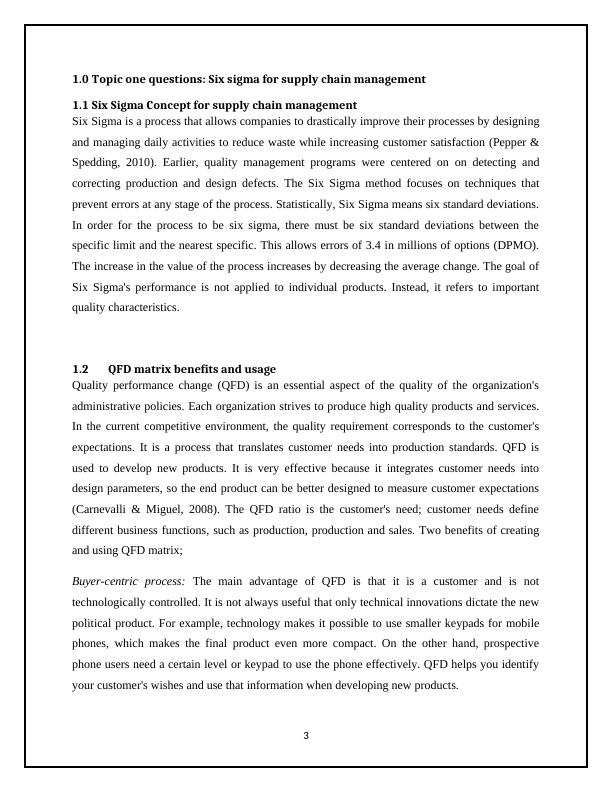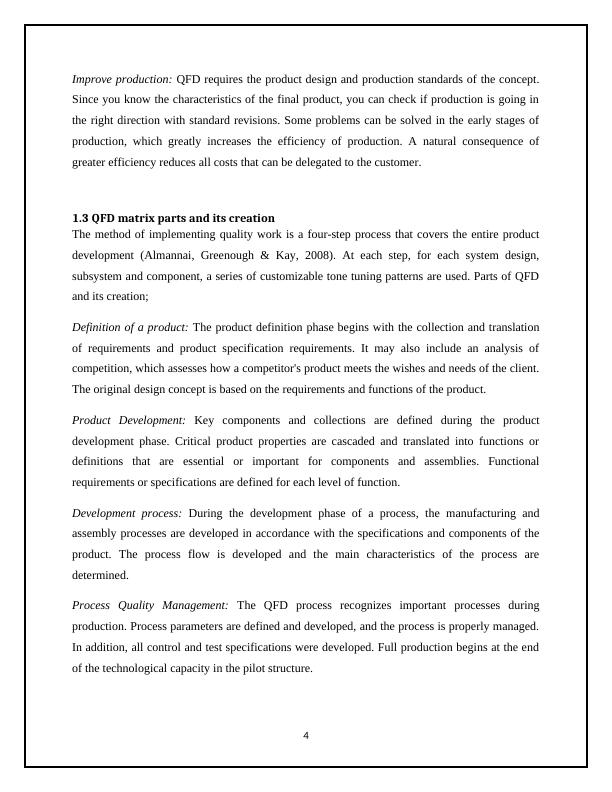Six Sigma for Supply Chain Management: Tools, Techniques and Applications
Added on 2023-06-03
15 Pages4499 Words311 Views
SIX SIGMA FOR SUPPLY CHAIN MANAGEMENT
1
1

Table of Contents
1.0 Topic one questions: Six sigma for supply chain management.................................................3
1.1 Six Sigma Concept for supply chain management................................................................3
1.2 QFD matrix benefits and usage.........................................................................................3
1.3 QFD matrix parts and its creation..........................................................................................4
1.3 The steps for benchmarking..............................................................................................5
1.5 Six Sigma tools and their placements;...................................................................................5
Affinity diagram.......................................................................................................................5
Kano model..............................................................................................................................5
Pareto analysis..........................................................................................................................6
Brainstorming...........................................................................................................................6
Fishbone analysis.....................................................................................................................6
Process flow charts...................................................................................................................7
Failure mode analysis...............................................................................................................7
Design of experiment...............................................................................................................7
1.6 DMAIC cycle, the final stage “control” accomplishment.....................................................7
1.7 Lean thinking advantages in integrating with six sigma & process improvement................8
1.8 Importance of creating value stream process maps...............................................................8
2.0 Topic Two questions: Design for six sigma for supply chain design........................................9
2.1 DFSS and its benefits in supply chain design and management............................................9
2.2 Redesign a supply chain process using DFSS.......................................................................9
3.0 Topic three questions: Six sigma applications in the supply chain.........................................10
3.1 Key factors for implementing a successful six sigma program for supply chain
management along with the obstacles and challenges of the six sigma method........................10
3.2 Six sigma applications for logistics and supply chain management....................................10
4.0 Topic four questions: SCOR and Six sigma............................................................................11
4.1 SCOR model with its strengths and weakness.....................................................................11
4.2 SCOR Six sigma (Lean) convergence, SCOR add to six sigma and vice versa, give an
example of an application..........................................................................................................12
REFERENCES..............................................................................................................................13
2
1.0 Topic one questions: Six sigma for supply chain management.................................................3
1.1 Six Sigma Concept for supply chain management................................................................3
1.2 QFD matrix benefits and usage.........................................................................................3
1.3 QFD matrix parts and its creation..........................................................................................4
1.3 The steps for benchmarking..............................................................................................5
1.5 Six Sigma tools and their placements;...................................................................................5
Affinity diagram.......................................................................................................................5
Kano model..............................................................................................................................5
Pareto analysis..........................................................................................................................6
Brainstorming...........................................................................................................................6
Fishbone analysis.....................................................................................................................6
Process flow charts...................................................................................................................7
Failure mode analysis...............................................................................................................7
Design of experiment...............................................................................................................7
1.6 DMAIC cycle, the final stage “control” accomplishment.....................................................7
1.7 Lean thinking advantages in integrating with six sigma & process improvement................8
1.8 Importance of creating value stream process maps...............................................................8
2.0 Topic Two questions: Design for six sigma for supply chain design........................................9
2.1 DFSS and its benefits in supply chain design and management............................................9
2.2 Redesign a supply chain process using DFSS.......................................................................9
3.0 Topic three questions: Six sigma applications in the supply chain.........................................10
3.1 Key factors for implementing a successful six sigma program for supply chain
management along with the obstacles and challenges of the six sigma method........................10
3.2 Six sigma applications for logistics and supply chain management....................................10
4.0 Topic four questions: SCOR and Six sigma............................................................................11
4.1 SCOR model with its strengths and weakness.....................................................................11
4.2 SCOR Six sigma (Lean) convergence, SCOR add to six sigma and vice versa, give an
example of an application..........................................................................................................12
REFERENCES..............................................................................................................................13
2

1.0 Topic one questions: Six sigma for supply chain management
1.1 Six Sigma Concept for supply chain management
Six Sigma is a process that allows companies to drastically improve their processes by designing
and managing daily activities to reduce waste while increasing customer satisfaction (Pepper &
Spedding, 2010). Earlier, quality management programs were centered on on detecting and
correcting production and design defects. The Six Sigma method focuses on techniques that
prevent errors at any stage of the process. Statistically, Six Sigma means six standard deviations.
In order for the process to be six sigma, there must be six standard deviations between the
specific limit and the nearest specific. This allows errors of 3.4 in millions of options (DPMO).
The increase in the value of the process increases by decreasing the average change. The goal of
Six Sigma's performance is not applied to individual products. Instead, it refers to important
quality characteristics.
1.2 QFD matrix benefits and usage
Quality performance change (QFD) is an essential aspect of the quality of the organization's
administrative policies. Each organization strives to produce high quality products and services.
In the current competitive environment, the quality requirement corresponds to the customer's
expectations. It is a process that translates customer needs into production standards. QFD is
used to develop new products. It is very effective because it integrates customer needs into
design parameters, so the end product can be better designed to measure customer expectations
(Carnevalli & Miguel, 2008). The QFD ratio is the customer's need; customer needs define
different business functions, such as production, production and sales. Two benefits of creating
and using QFD matrix;
Buyer-centric process: The main advantage of QFD is that it is a customer and is not
technologically controlled. It is not always useful that only technical innovations dictate the new
political product. For example, technology makes it possible to use smaller keypads for mobile
phones, which makes the final product even more compact. On the other hand, prospective
phone users need a certain level or keypad to use the phone effectively. QFD helps you identify
your customer's wishes and use that information when developing new products.
3
1.1 Six Sigma Concept for supply chain management
Six Sigma is a process that allows companies to drastically improve their processes by designing
and managing daily activities to reduce waste while increasing customer satisfaction (Pepper &
Spedding, 2010). Earlier, quality management programs were centered on on detecting and
correcting production and design defects. The Six Sigma method focuses on techniques that
prevent errors at any stage of the process. Statistically, Six Sigma means six standard deviations.
In order for the process to be six sigma, there must be six standard deviations between the
specific limit and the nearest specific. This allows errors of 3.4 in millions of options (DPMO).
The increase in the value of the process increases by decreasing the average change. The goal of
Six Sigma's performance is not applied to individual products. Instead, it refers to important
quality characteristics.
1.2 QFD matrix benefits and usage
Quality performance change (QFD) is an essential aspect of the quality of the organization's
administrative policies. Each organization strives to produce high quality products and services.
In the current competitive environment, the quality requirement corresponds to the customer's
expectations. It is a process that translates customer needs into production standards. QFD is
used to develop new products. It is very effective because it integrates customer needs into
design parameters, so the end product can be better designed to measure customer expectations
(Carnevalli & Miguel, 2008). The QFD ratio is the customer's need; customer needs define
different business functions, such as production, production and sales. Two benefits of creating
and using QFD matrix;
Buyer-centric process: The main advantage of QFD is that it is a customer and is not
technologically controlled. It is not always useful that only technical innovations dictate the new
political product. For example, technology makes it possible to use smaller keypads for mobile
phones, which makes the final product even more compact. On the other hand, prospective
phone users need a certain level or keypad to use the phone effectively. QFD helps you identify
your customer's wishes and use that information when developing new products.
3

Improve production: QFD requires the product design and production standards of the concept.
Since you know the characteristics of the final product, you can check if production is going in
the right direction with standard revisions. Some problems can be solved in the early stages of
production, which greatly increases the efficiency of production. A natural consequence of
greater efficiency reduces all costs that can be delegated to the customer.
1.3 QFD matrix parts and its creation
The method of implementing quality work is a four-step process that covers the entire product
development (Almannai, Greenough & Kay, 2008). At each step, for each system design,
subsystem and component, a series of customizable tone tuning patterns are used. Parts of QFD
and its creation;
Definition of a product: The product definition phase begins with the collection and translation
of requirements and product specification requirements. It may also include an analysis of
competition, which assesses how a competitor's product meets the wishes and needs of the client.
The original design concept is based on the requirements and functions of the product.
Product Development: Key components and collections are defined during the product
development phase. Critical product properties are cascaded and translated into functions or
definitions that are essential or important for components and assemblies. Functional
requirements or specifications are defined for each level of function.
Development process: During the development phase of a process, the manufacturing and
assembly processes are developed in accordance with the specifications and components of the
product. The process flow is developed and the main characteristics of the process are
determined.
Process Quality Management: The QFD process recognizes important processes during
production. Process parameters are defined and developed, and the process is properly managed.
In addition, all control and test specifications were developed. Full production begins at the end
of the technological capacity in the pilot structure.
4
Since you know the characteristics of the final product, you can check if production is going in
the right direction with standard revisions. Some problems can be solved in the early stages of
production, which greatly increases the efficiency of production. A natural consequence of
greater efficiency reduces all costs that can be delegated to the customer.
1.3 QFD matrix parts and its creation
The method of implementing quality work is a four-step process that covers the entire product
development (Almannai, Greenough & Kay, 2008). At each step, for each system design,
subsystem and component, a series of customizable tone tuning patterns are used. Parts of QFD
and its creation;
Definition of a product: The product definition phase begins with the collection and translation
of requirements and product specification requirements. It may also include an analysis of
competition, which assesses how a competitor's product meets the wishes and needs of the client.
The original design concept is based on the requirements and functions of the product.
Product Development: Key components and collections are defined during the product
development phase. Critical product properties are cascaded and translated into functions or
definitions that are essential or important for components and assemblies. Functional
requirements or specifications are defined for each level of function.
Development process: During the development phase of a process, the manufacturing and
assembly processes are developed in accordance with the specifications and components of the
product. The process flow is developed and the main characteristics of the process are
determined.
Process Quality Management: The QFD process recognizes important processes during
production. Process parameters are defined and developed, and the process is properly managed.
In addition, all control and test specifications were developed. Full production begins at the end
of the technological capacity in the pilot structure.
4

End of preview
Want to access all the pages? Upload your documents or become a member.
Related Documents
Lean Six Sigma: Study Material with Solved Assignments and Essayslg...
|20
|4183
|210
Six Sigma Methodologylg...
|4
|774
|228
19. 19 PROFESSIONAL PROJECT. : PROFESSIONAL PROJECT. Prlg...
|24
|6411
|2
Logistics: Six Sigma, Lean Management, 4P Logistics, Fishbone Analysis and Solutionslg...
|13
|2893
|400
Lean Six Sigma and Total Quality Managementlg...
|11
|2345
|318
Lean Management and Six Sigmalg...
|6
|1071
|95
